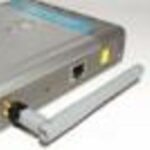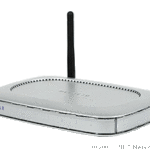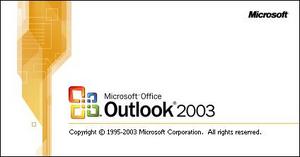The SMC WiFi Skype Phone (WSKP100) and the Netgear WiFi Skype Phone (SPH101) are both white. They can both make calls using the popular Voice-over-IP (VoIP) Skype service, and both are able to utilize open wireless networks without having to connect to a computer or actual phone line. The similarities between these two wireless, Skype-certified phones end there.
SMC and Netgear’s Skype phones show just how much Apple Computer’s iPod has influenced the designs of technological hardware. Both phones are iPod white. However, unlike the iPod, both Skype phones sport an almost-confusing array of buttons to access their different functions.
The Netgear WiFi Skype Phone (SPH101) is slightly shorter, skinnier, and thicker than the SMC WiFi Skype Phone (WSKP100). When looking for a phone to use with my Skype account, size was a very important factor. When reviewing these two phones, I didn’t notice too much of a difference in their size, with the difference on paper being a mere two to five millimeters and both weighing about a fourth of a pound. Both Skype phones are about the size of an open cellphone, fitting easily in the palm of your hand. Both Skype phones can easily be placed in a purse or bag, although they might be a little too big to fit comfortably in a slim pair of jeans.
SMC was the first company to launch a Skype-certified wireless phone. The main draw for their phone is its capability to connect to open wireless Internet networks over both 802.11g and the older, slower 802.11b standard. Netgear’s SPH101 phone supports both g/b networks, too.
Netgear’s SPH101 phone promises about two hours of talk time, which I found to be relatively accurate. Standby time (time that the phone can be on while not making or receiving phone calls) met the promised 20 hours. SMC’s WSKP100 phone fared remarkably similar. Two hours is not a lot of talk time. However, both phones are basically miniature computers running the Skype software, which eats up an understandably large amount of batter power.
The screen of the phones are similar, both the Netgear SPH101 and SMC WSKP100 Skype phones sporting a blue screen over which the text appears relatively clear and crisp. However, the SMC WSKP100 is hard to see in bright sunlight, with the colors appearing washed out. Netgear’s Skype phone was also washed out in the sunlight, but not as bad as the SMC phone. However, it should be pointed out that both screens were still readable, and you will not be looking at the screen for a long period of time.
Setting up the SMC WSKP100 Skype phone was easy. After I opened my box (which was shipped with a manual on a CD, a power adapter, a chord to connect the phone to my computer, and a FON wireless router), I followed the sticker prominently placed on the phone and charged the battery for eight hours. Upon completion of the charging cycle (which, while charging, displays a battery icon on the phone’s screen), I powered the phone on. The WSKP100 chimed and a spinning “Skype” icon appeared on the blue screen. After a few seconds of loading, I was asked to agree to a User’s Agreement. The phone then looked for an open internet connection. After it found my home wireless network (an 802.11g WiFi network), it asked if I would like to connect. After I agreed, it asked for my WiFi password since the connection was a secure one.
Here came an important part: I had to use the phone’s keypad to enter in my information. SMC did a good job of designing the interface intuitively. When pressing a key repeatedly, you toggle between numbers and letters. When you find the letter you want, simply release the key and the phone will insert that letter or number. Thus, entering my WiFi information took a very short amount of time and I was soon connected to the internet.
Once online, the phone allowed me to enter in my current Skype account information. If I didn’t have one, it also gave me a choice to create a new account. Since I already had an account with Skype, I logged in. The phone downloaded my Skype contact list and information, and I was ready to make my first phone call!
The Netgear SPH101’s setup process was very similar. As with the SMC WSKP100, Netgear logs you in. If you are trying to access a closed network, you will have to enter in your information using the phone’s keypad. I found the buttons responsive and they felt solid, a little more so than with SMC’s phone.
Once online, the SPH101 asked me to enter in my Skype logon info, after which it downloaded my information off of Skype’s server and I was ready to go.
Making a phone call on the two phones were practically identical. You could either follow the on-screen guides and call someone from your Skype contact list (which is updated automatically via each phone’s respective connection to Skype’s servers), or you could dial a number or Skype name by using each phone’s respective keyboard. As noted earlier, the Netgear SPH101’s keys felt slightly better than SMC’s WSKP100. However, SMC’s phone was more than satisfactory and met the needs I was using it for.
One of the most important factors I was looking for was call quality. Both phones suffer from a short lag-time when calling a telephone landline. There was also static on both phones, but this was intermittent and rarely affected the quality of my phone call. With the SMC WSKP100 phone, the person I was talking to heard static when I didn’t. Once again, this was occasional and rarely affected the call quality.
Calls made on both phones to computer Skype accounts were much clearer and did not suffer from the lag experienced when calling a landline.
The final comparison to be made was price. Netgear’s SPH101 WiFi Skype phone retails at $169.99. At the time of publication, the official Skype.com store offered a $50 mail-in rebate upon checkout. The price for Netgear’s phone includes the phone itself, as well as all chords and cables you will need to operate it.
SMC’s WSKP100 WiFi Skype Phone is a much better deal than Netgear’s phone. It retails for $159.99 at the official Skype.com store. However, it does not just include the phone. When purchasing, you also receive a voucher for 500 free Skype-out minutes (good for calling non-Skype users, such as landlines) as well as a year of free Skype voicemail. In addition to this, you also receive a FON wireless router that you can use to share your WiFi network and gives you free access to FON’s wireless services around the globe.
In summar, the SMC WSKP100 WiFi Skype Phone is cheaper than the Netgear SPH101 WiFi Skype phone. Both look similar, cosmetically, with the Netgear SPH101 doing better in bright sunlight than the SMC WSKP100. The Netgear phone’s keypad also felt a little more solid than the SMC phone, but this does not affect performance. Likewise, both phones had similar sound quality, with intermittent static and occasional lags which cleared up when calling Skype users, but reasserted themselves when calling landlines.
In the end, I chose the SMC WSKP100 Wifi Skype phone. However, both phones are so similar that you couldn’t go too wrong with either of them. With a price difference of about $50, it is hard to find a major fault in either wireless phone.




